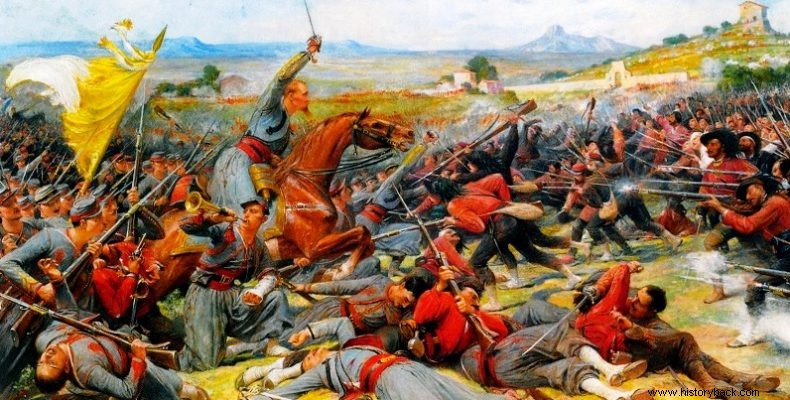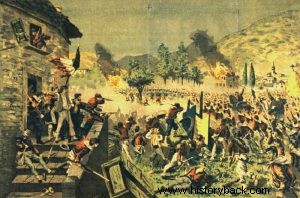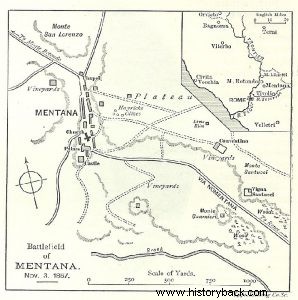
In 1867 the situation in Italy was once again tense. In 1866 the Italian kingdom of Piedmont was defeated by the Austrians but thanks to the Prussian victory at Sandova (Königgratz) they won Mantua and Venice. At the same time, the Italian kingdom placed under its "patronage" the papal state that until then was protected by France.
Nevertheless, Giuseppe Garibaldi decided to immediately "clean up" the situation by occupying Rome. Garibaldi called the pope a "disgrace and a wound" for Italy and after gathering 10,000 men he marched towards the Eternal City.
Invasion…
The Garibaldi invaded Latium in October 1867. They then came to terms with friends close to their movement in Rome and planned the surprise capture of the city. So on October 22, 70 Garibaldi sailed in boats to Rome from the river Tiber. At the same time, a movement in favor of the Garibaldians took place in the city. The rebels blew up part of the city's fortifications, killing 27 papal soldiers of the elite regiment of the Zouaves.
However, the papal troops suppressed the rebellion and when they arrived in the boats the Garibaldians were surrounded by the papal Zouaves and neutralized. In the meantime Garibaldi approached Rome with the bulk of his forces but after some skirmishes retreated.
Papal counterattack
Having finally suppressed the rebellion in Rome, the papists prepared to fight back, although they were dramatically outnumbered. The papal power under German general Hermann Kanzler it had 5,100 men. This force was organized into two phalanxes.
The first under Swiss de Courte consisted of the Constitution of the Zouaves (2 battalions – 1,500 men), the Foreign Carabinieri Battalion (Swiss snipers) with about 500 men, the Antibes Volunteer Battalion (French, Belgian and other volunteers – 540 men), a dragoon company (106 horsemen), a company of pioneers ( 80 men), a gendarmerie section (50 men) and an artillery unit with six light guns. The second phalanx, under Gallo de Pole, extended 2,000 French infantry and 100 cavalry (50 French, 50 Papists) and 3 or 4 light guns.
The battle
The morning of November 3, 1867 was dark and wet. The small papal army left Rome and moved towards the small village of Mentana about 20 km away from the city. Garibaldi's forces were fortified there. So the "Red-robed" Garibaldians had a numerical advantage and were fortified. The fate of the coming battle seemed predetermined, but there were also the Zouaves... The German general of the papists approaching Medana ordered three companies of Zouaves to move behind the right wing of the Garibaldi.
The rest of his force moved up against their opponents with the French following about 2km behind. When he saw the enemy Chancellor ordered his men to immediately attack the three opposing battalions in front of them. And so it happened.
Four companies of Zouaves moved in a strafing formation and soon cleared the adjacent woods of the enemy. Then the commander of the regiment of Jouaves de Charette took the lead and led his men with a lance against the enemy. The Garibaldians could not stand the raid and put it to rest.
They only stopped running when they reached the fortified Saducci vineyard. The vineyard was surrounded by thick walls and inside there was a stone house. The Zouaves immediately attacked, supported by the Swiss Carabinieri and the Antibes Legion. However, their first attack was repelled.
However, de Charette, on horseback, shouted to his men:Forward Zouaves with me, or I will die alone! Then with sword pointed at the enemy, still bleeding, with the hat of a Garibaldian officer he had just killed pinned on, he came forward defying the bullets...
And his Zouaves did not let him down. The colonel's horse was mowed down by the fire. Captain de Beaux fell beside him. Nevertheless, the Zouaves, climbing the wall, put the Garibaldians to flight who were now fortified in the monastery of Il Conventino. With the support of the artillery, the Zouaves attacked and captured the monastery, supported by the Swiss.
Soon the Garibaldians retreated from there too before the bayonets of the Zouaves. Garibaldi then ordered his forces into the walled village and its castle. There, with the help of their artillery, they stopped the papists and launched an attack against both sides of the much smaller papists.
On one wing, the Garibaldians engaged in a fierce battle with the Swiss, who, however, proved to be much better than them. The few Swiss not only repulsed the attack but put to flight and pursued their opponents. The same fate had the attack of the Garibaldians on the other wing where they were crushed by the Legion of Antibes.
Seeing the defeat in the wings Garibaldi attacked the papal center against the Zouaves throwing every available man into the battle. However, the Zouaves endured. Chancellor had asked the French to intervene, but almost didn't have to.
Colonel Ale's attitude is worth mentioning. Seeing an opponent marking him, the colonel stood still. Any fainting of his would probably shake his men. Garibaldi fired but missed. Then Ale laughed and said to his men:“See how stupid he is. He aimed, shot and missed me. Give me a rifle." He took it, marked and killed the opponent.
In the meantime, the three companies of Zouaves who had taken charge of the Garibaldians appeared in the enemy's rear, while the French also entered, at last, into the fight against the enemy's left flank. The Garibaldians could not stand it and fled in disorder. The battle was over. The vanquished had over 2,100 dead, wounded and captured, compared to only 144 dead and wounded of the papists... Virtually 3,000 papal soldiers single-handedly defeated three times as many enemies.


